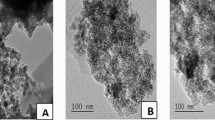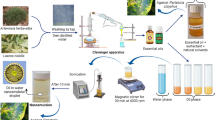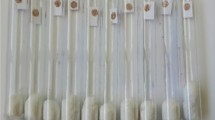Abstract
The red flour beetle, Tribolium castaneum Herbst (Coleoptera: Tenebrionidae), is an economically important pest of stored products. As possible alternative to conventional insecticides for its management, plant essential oils have gained interest owing to their effectiveness and eco-friendly features. However, they also show some drawbacks, such as low stability, poor water solubility and diffusion, and limited persistence in the environment. A good strategy to overcome these disadvantages is represented by green nanotechnologies. Herein, we developed a nanoemulsion based on the essential oil from Pimpinella anisum L. (Apiaceae) containing 81.2% of (E)-anethole and evaluated its toxicity on T. castaneum adults and F1 progeny, as well as its morphological and histological impact. The aniseed oil nanoemulsion was characterized by the formation of a semi-solid interphase between oil and water; mean drop size was 198.9 nm, PDI was 0.303, zeta potential was − 25.4 ± 4.47 mV, and conductivity was 0.029 mS/cm. The nanoemulsion showed toxicity on T. castaneum (LC50 = 9.3% v/v), with a significant impact on its progeny. Morphological and histological damages triggered by feeding and exposure to the aniseed nanoemulsion were analyzed by scanning electron microscopy (SEM) and light microscopy. Overall, our findings showed that the development of nanoemulsions allows to improve the stability of P. anisum essential oil enhancing its efficacy against stored grain pests and contributing to reduce the use of harmful synthetic insecticides.






Similar content being viewed by others
References
Awadalla SS, Zayed GM, Hashem AS (2017) Chemical composition and bioactivity of three plant essential oils against Tribolium castaneum (Herbst) and Sitophilus oryzae (L.). J Plant Prot Path Mansoura Univ 8:535-539
Abbott WS (1925) A method of computing the effectiveness of an insecticide. J Econ Entomol 18:265–267
Afshar FH, Maggi F, Iannarelli R, Cianfaglione K, Isman MB (2017) Comparative toxicity of Helosciadium nodiflorum essential oils and combinations of their main constituents against the cabbage looper, Trichoplusia ni (Lepidoptera). Ind Crop Prod 98:46–52
Aktar W, Sengupta D, Chowdhury A (2009) Impact of pesticides use in agriculture: their benefits and hazards. Interdiscip Toxicol 2:1–12
Arancibia C, Navarro-Lisboa R, Zúniga RN, Matiacevich S (2016) Application of CMC as thickener on nanoemulsions based on olive oil: physical properties and stability. Int J Polym Sci 6280581
Arthur FH (1996) Grain protectants: current status and prospects for the future. J Stored Prod Res 32:293–302
Arthur FH, Hagstrum DW, Flinn PW, Reed CR, Phillips TW (2006) Insect populations in grain residues associated with commercial Kansas grain elevators. J Stored Prod Res 42:226–239
Athanassiou CG, Kavallieratos NG, Benelli G, Losic D, Usha Rani P, Desneux N (2018) Nanoparticles for pest control: current status and future perspectives. J Pest Sci 91:1–15
Benelli G (2018a) Gold nanoparticles—against parasites and insect vectors. Acta Trop 178:73–80
Benelli G (2018b) Plant-borne compounds and nanoparticles: challenges for medicine, parasitology and entomology. Environ Sci Poll Res 25:10149–10150
Benelli G (2018c) Mode of action of nanoparticles against insects. Environ Sci Poll Res, https://doi.org/10.1007/s11356-018-1850-4
Benelli G, Lukehart CM (2017) Special issue: applications of green-synthesized nanoparticles in pharmacology, parasitology and entomology. J Clust Sci 28:1–2
Benelli G, Pavela R (2018a) Repellence of essential oils and selected compounds against ticks—a systematic review. Acta Trop 179:47–54
Benelli G, Pavela R (2018b) Beyond mosquitoes—Essential oil toxicity and repellency against bloodsucking insects. Ind Crops Prod 117:382-392
Benelli G, Pavela R, Iannarelli R, Petrelli R, Cappellacci L, Cianfaglione K, Afshar FH, Nicoletti M, Canale A, Maggi F (2017a) Synergized mixtures of Apiaceae essential oils and related plant-borne compounds: larvicidal effectiveness on the filariasis vector Culex quinquefasciatus Say. Ind Crop Prod 96:186–195
Benelli G, Pavela R, Maggi F, Petrelli R, Nicoletti M (2017b) Commentary: making green pesticides greener? The potential of plant products for nanosynthesis and pest control. J Clust Sci 28:3–10
Benelli G, Pavela R, Giordani C, Casettari L, Curzi G, Cappellacci L, Petrelli R, Maggi F (2018) Acute and sub-lethal toxicity of eight essential oils of commercial interest against the filariasis mosquito Culex quinquefasciatus and the housefly Musca domestica. Ind Crop Prod 112:668–680
Berne BJ, Pecora R (2000) Dynamic light scattering: with applications to chemistry, biology, and physics. Courier Corporation
Bordes P, Pollet E, Avérous L (2009) Nano-biocomposites: biodegradable polyester/nanoclay systems. Prog Polym Sci 34:125–155
Bossou AD, Ahoussi E, Ruysbergh E, Adams A, Smagghe G, De Kimpe N, Mangelinckx S (2015) Characterization of volatile compounds from three Cymbopogon species and Eucalyptus citriodora from Benin and their insecticidal activities against Tribolium castaneum. Ind Crop Prod 76:306–317
Campolo O, Romeo FV, Malacrinò A, Laudani F, Carpinteri G, Fabroni S, Rapisarda P, Palmeri V (2014) Effects of inert dusts applied alone and in combination with sweet orange essential oil against Rhyzopertha dominica (Coleoptera: Bostrichidae) and wheat microbial population. Ind Crop Prod 61:361–369
Campolo O, Cherif A, Ricupero M, Siscaro G, Grissa-Lebdi K, Russo A, Cucci LM, Di Pietro P, Satriano C, Desneux N, Biondi A, Zappalà L, Palmeri V (2017) Citrus peel essential oil nanoformulations to control the tomato borer, Tuta absoluta: chemical properties and biological activity. Sci Rep 7:13036
Cardiet G, Fuzeau B, Barreau C, Fleurat-Lessard F (2012) Contact and fumigant toxicity of some essential oil constituents against a grain insect pest Sitophilus oryzae and two fungi, Aspergillus westerdijkiae and Fusarium graminearum. J Pest Sci 85:351–358
Carvalho SSD, Vendramim JD, Sá ICGD, Silva MFDGF, Ribeiro LDP, Forim MR (2015) Systemic insecticidal effect of neem-based nanoformulations against Bemisia tabaci (Hemiptera: Aleyrodidae) biotype B in tomato. Bragantia 74:298–306
Cespi M, Quassinti L, Perinelli DR, Bramucci M, Iannarelli R, Papa F, Ricciutelli M, Bonacucina G, Palmieri GF, Maggi F (2017) Microemulsions enhance the shelf-life and processability of Smyrnium olusatrum L. essential oil. Flavour Fragr J 32:159–164
Chang CL, Cho IK, Li QX (2009) Insecticidal activity of basil oil, trans-anethole, estragole, and linalool to adult fruit flies of Ceratitis capitata, Bactrocera dorsalis, and Bactrocera cucurbitae. J Econ Entomol 102:203–209
da Costa JT, Forim MR, Costa ES, De Souza JR, Mondego JM, Junior ALB (2014) Effects of different formulations of neem oil-based products on control Zabrotes subfasciatus (Boheman, 1833) (Coleoptera: Bruchidae) on beans. J Stored Prod Res 56:49–53
Debnath N, Das S, Seth D, Chandra R, Bhattacharya S, Goswami A (2011) Entomotoxic effect of silica nanoparticles against Sitophilus oryzae (L.). J Pest Sci 84:99–105
Domínguez J, Marrero L (2010) A catalogue of detected pest insects associated to food warehouses in Matanzas Province. Fitosanidad 14:75–78
Ebeling W (1971) Sorptive dust for pest control. Annu Rev Entomol 16:123–158
Fabres A, da Silva JDCM, Fernandes KV, Xavier-Filho J, Rezende GL, Oliveira AEA (2014) Comparative performance of the red flour beetle Tribolium castaneum (Coleoptera: Tenebrionidae) on different plant diets. J Pest Sci 87:495–506
Finney DJ (1971) Probit analysis: 3d Ed. Cambridge University Press
Galvão JG, Silva VF, Ferreira SG, França FRM, Santos DA, Freitas LS, Alves PB, Araújo AAS, Cavalcanti SCH, Nunes RS (2015) β-cyclodextrin inclusion complexes containing Citrus sinensis (L.) Osbeck essential oil: an alternative to control Aedes aegypti larvae. Thermochim Acta 608:14–19
González JOW, Gutiérrez MM, Ferrero AA, Band BF (2014) Essential oils nanoformulations for stored-product pest control—characterization and biological properties. Chemosphere 100:130–138
Hamouda IS, Elyassaki WM, Hamed MS (1996) Toxicity and histopathological effects of Artemisia judaica and Anagallis arvensis extracts on Culex pipens larvae. J Egypt Germ Soc Zool 20:43–60
Hamouda T, Hayes MM, Cao Z, Tonda R, Johnson K, Wright DC, Brisker J, Baker Jr JR (1999) A novel surfactant nanoemulsion with broad-spectrum sporicidal activity against Bacillus species. J Infect Dis 180:1939–1949
Hoeller S, Sperger A, Valenta C (2009) Lecithin based nanoemulsions: a comparative study of the influence of non-ionic surfactants and the cationic phytosphingosine on physicochemical behaviour and skin permeation. Int J Pharm 370:181–186
Iannarelli R, Caprioli G, Sut S, Dall’Acqua S, Fiorini D, Vittori S, Maggi F (2017) Valorizing overlooked local crops in the era of globalization: the case of aniseed (Pimpinella anisum L.) from Castignano (central Italy). Ind Crop Prod 104:99–110
Iannarelli R, Marinelli O, Morelli MB, Santoni G, Amantini C, Nabissi M, Maggi F (2018) Aniseed (Pimpinella anisum L.) essential oil reduces pro-inflammatory cytokines and stimulates mucus secretion in primary airway bronchial and tracheal epithelial cell lines. Ind Crops Prod. 114:81-86, https://doi.org/10.1016/j.indcrop.2018.01.076
Isman MB (2006) Botanical insecticides, deterrents, and repellents in modern agriculture and an increasingly regulated world. Annu Rev Entomol 51:45–66
Jankowska, M., Rogalska, J., Wyszkowska, J., Stankiewicz, M. (2017). Molecular Targets for Components of Essential Oils in the Insect Nervous System—A Review. Molecules, 23(1), 34. doi: 10.3390/molecules23010034
Joe MM, Bradeeba K, Parthasarathi R, Sivakumaar PK, Chauhan PS, Tipayno S, Benson A, Sa A (2012) Development of surfactin based nanoemulsion formulation from selected cooking oils: evaluation for antimicrobial activity against selected food associated microorganisms. J Taiwan Inst Chem Eng 43:172–180
Kah M, Beulke S, Tiede K, Hofmann T (2013) Nanopesticides: state of knowledge, environmental fate, and exposure modeling. Crit Rev Environ Sci Technol 43:1823–1867
Kanda D, Kaur S, Koul O (2017) A comparative study of monoterpenoids and phenylpropanoids from essential oils against stored grain insects: acute toxins or feeding deterrents. J Pest Sci 90:531–545
Kavallieratos NG, Athanassiou CG, Peteinatos GG, Boukouvala MC, Benelli G (2018) Insecticidal effect and impact on fitness of three diatomaceous earths on different maize hybrids for the eco-friendly control of the invasive stored-product pest Prostephanus truncatus (Horn). Environ Sci Pollut Res 25:10407–10417. https://doi.org/10.1007/s11356-017-9565-5
Khot L, Sankaran S, Maja J, Ehsani R, Schuster E (2012) Applications of nanomaterials in agricultural production and crop protection: a review. Crop Prot 35:64–70
Kim Y, Park J, Kumar S, Kwon H, Na J, Chun Y, Kim W (2015) Insecticidal activity of chlorine dioxide gas by inducing an oxidative stress to the red flour beetle, Tribolium castaneum. J Stored Prod Res 64:88–96
Kimbaris CA, Koliopoulos G, Michaelakis A, Konstantopoulou MA (2012) Bioactivity of Dianthus caryophyllus, Lepidium sativum, Pimpinella anisum, and Illicium verum essential oils and their major components against the west Nile vector Culex pipiens. Parasitol Res 111:2403–2410
Lashgari A, Mashayekhi S, Javadzadeh M, Marzban R (2014) Effect of Mentha piperita and Cuminum cyminum essential oil on Tribolium castaneum and Sitophilus oryzae. Arch Phytopathol Plant Protect 47:324–329
Lee HK, Lee HS (2016) Toxicities of active constituent isolated from Thymus vulgaris flowers and its structural derivatives against Tribolium castaneum (Herbst). Appl Biol Chem 59:821–826
Lett AM (2016) Microstructure engineering of emulsion-based systems for the control of satiation, satiety, hedonic acceptability and sensory quality (Doctoral dissertation, University of Birmingham, UK)
Liang JY, Wang WT, Zheng YF, Zhang D, Wang JL, Guo SS, Zhang J (2017) Bioactivities and chemical constituents of essential oil extracted from Artemisia anethoides against two stored product insects. J Oleo Sci 66:71–76
Liu X, Vinson D, Abt D, Hurt RH, Rand DM (2009) Differential toxicity of carbon nanomaterials in Drosophila: larval dietary uptake is benign, but adult exposure causes locomotor impairment and mortality. Environ Sci Technol 43:6357–6363
Montefuscoli AR, González JOW, Palma SD, Ferrero AA, Band BF (2014) Design and development of aqueous nanoformulations for mosquito control. Parasitol Res 113:793–800
Moretti MD, Sanna-Passino G, Demontis S, Bazzoni E (2002) Essential oil formulations useful as a new tool for insect pest control. AAPS Pharm Sci Technol 3:64–74
Nakajima H (1997) Microemulsions in cosmetics. Surfactant Sci Ser 66:175–197
Nauen R, Stumpf N, Elbert A (2002) Toxicological and mechanistic studies on neonicotinoid cross resistance in Q-type Bemisia tabaci (Hemiptera: Aleyrodidae). Pest Manag Sci 58:868–875
Nenaah G (2014) Chemical composition, toxicity and growth inhibitory activities of essential oils of three Achillea species and their nano-emulsions against Tribolium castaneum (Herbst). Ind Crop Prod 53:252–260
Nenaah GE, Ibrahim SI (2011) Chemical composition and the insecticidal activity of certain plants applied as powders and essential oils against two stored-products coleopteran beetles. J Pest Sci 84:393–402
Nenaah GE, Ibrahim SI, Al-Assiuty BA (2015) Chemical composition, insecticidal activity and persistence of three Asteraceae essential oils and their nanoemulsions against Callosobruchus maculatus (F.). J Stored Prod Res 61:9–16
Nukenine EN, Adler C, Reichmuth C (2007) Efficacy evaluation of plant powders from Cameroon as post-harvest grain protectants against the infestation of Sitophilus zeamais Motschulsky (Coleoptera: Curculionidae). J Plant Dis Prot 114:30–36
Oberdörster G, Oberdörster E, Oberdörster J (2005) Nanotoxicology: discipline evolving from studies of ultrafine particles. Environ Health Perspect 113:823–839
Oliveira AE, Duarte JL, Amado JR, Cruz RA, Rocha CF, Souto RN, Kelecom A (2016) Development of a larvicidal nanoemulsion with Pterodon emarginatus Vogel oil. PLoS One 11:0145835
Oliveira AP, Santana AS, Santana ED, Lima APS, Faro RR, Nunes RS, Bacci L (2017) Nanoformulation prototype of the essential oil of Lippia sidoides and thymol to population management of Sitophilus zeamais (Coleoptera: Curculionidae). Ind Crop Prod 107:198–205
Opit GP, Phillips TW, Aikins MJ, Hasan MM (2012) Phosphine resistance in Tribolium castaneum and Rhyzopertha dominica from stored wheat in Oklahoma. J Econ Entomol 105:1107–1114
Park IK, Choi KS, Kim DH, Choi IH, Kim LS, Bak WC, Choi JW, Shin SC (2006) Fumigant activity of plant essential oils and components from horseradish (Armoracia rusticana), anise (Pimpinella anisum), and garlic (Allium sativum) oils against Lycoriella ingenua. Pest Manag Sci 62:723–728
Patakangas J (2014) Investigation of electrolyte materials and measurement techniques for nanocomposite fuel cells. Thesis, Advanced Energy Systems, Aalto University, pp. 78
Pavela R (2014) Insecticidal properties of Pimpinella anisum essential oils against the Culex quinquefasciatus and the non-target organism Daphnia magna. J Asia Pac Entomol 17:287–293
Pavela R (2015) Acute toxicity and synergistic and antagonistic effects of the aromatic compounds of some essential oils against Culex quinquefasciatus Say larvae. Parasitol Res 114:3835–3853
Pavela R (2016) History, presence and perspective of using plant extracts as commercial botanical insecticides and farm products for protection against insects—a review. Plant Prot Sci 52:229–241
Pavela R, Benelli G (2016a) Ethnobotanical knowledge on botanical repellents employed in the African region against mosquito vectors—a review. Exp Parasitol 167:103–108
Pavela R, Benelli G (2016b) Essential oils as eco-friendly biopesticides? Challenges and constraints. Trends Plant Sci 21:1000–1007
Pavela R, Žabka M, Vrchotová N, Tříska J (2018a) Effect of foliar nutrition on the essential oil yield of thyme (Thymus vulgaris L.). Ind Crop Prod 112:762–765
Pavela R, Maggi F, Lupidi G, Mbuntcha H, Woguem V, Womeni HM, Barboni L, Tapondjou LA, Benelli G (2018b) Clausena anisata and Dysphania ambrosioides essential oils: from ethno-medicine to modern uses as effective insecticides. Environ Sci Pollut Res 25:10493–10503. https://doi.org/10.1007/s11356-017-0267-9
Phankaen Y, Manaprasertsak A, Pluempanupat W, Koul O, Kainoh Y, Bullangpoti V (2017) Toxicity and repellent action of Coffea arabica against Tribolium castaneum (Herbst) adults under laboratory conditions. J Stored Prod Res 71:112–118
Prasantha BDR, Reichmuth C, Adler C, Felgentreu D (2015) Lipid adsorption of diatomaceous earths and increased water permeability in the epicuticle layer of the cowpea weevil Callosobruchus maculatus (F.) and the bean weevil Acanthoscelides obtectus (Say) (Chrysomelidae). J Stored Prod Res 64:36–41
Rigaux M, Haubruge E, Fields PG (2001) Mechanisms for tolerance to diatomaceous earth between strains of Tribolium castaneum. Entomol Exp Appl 101:33–39
Romeo FV, De Luca S, Piscopo A, Poiana M (2008) Antimicrobial effect of some essential oils. J Essent Oil Res 20:373–379
Ryan MF, Byrne O (1988) Plant–insect coevolution and inhibition of acetyl cholinesterase. J Chem Ecol 14:965–1975
Sasson Y, Levy-Ruso G, Toledano O, Ishaaya I (2007) Nanosuspensions: emerging novel agrochemical formulations. In: Ishaaya I, Nauen R, Horowitz AR (eds) Insecticides design using advanced technologies. Springer, Berlin, pp 1–32
Schluter U (1986) Effects of azadirachtin on developing tissues of various insect larvae. Proc 3rd Int Neem Conf, pp 331–348
Schuler MA (1996) The role of cytochrome 450 monooxygenases in plant insect interactions. Plant Physiol 112:1411–1419
Shaaya E, Kostjukovski M, Eilberg J, Sukprakarn C (1997) Plant oils as fumigants and contact insecticides for the control of stored-product insects. J Stored Prod Res 33:7–15
Shi B, Wang Z, Wen H (2017) Research on the strengths of electrostatic and van der Waals interactions in ionic liquids. J Mol Liq 241:486–488
Silver K, Jiang H, Fu J, Phillips TW, Beeman RW, Park Y (2014) The Tribolium castaneum cell line TcA: a new tool kit for cell biology. Sci Rep 4:6840
Sonneville-Aubrun O, Simonnet JT, Lalloret F (2004) Nanoemulsions: a new vehicle for skincare products. Adv Colloid Interf Sci 108:145–149
Strobl F, Schmitz A, Stelzer EH (2015) Live imaging of Tribolium castaneum embryonic development using light-sheet-based fluorescence microscopy. Nat Prot 10:1486–1507
Sugumar S, Clarke SK, Nirmala MJ, Tyagi BK, Mukherjee A, Chandrasekaran N (2014) Nanoemulsion of eucalyptus oil and its larvicidal activity against Culex quinquefasciatus. Bull Entomol Res 104:393–402
Suresh Kumar RS, Shiny PJ, Anjali CH, Jerobin J, Goshen KM, Magdassi S, Mukherjee A, Chandrasekaran N (2013) Distinctive effects of nano-sized permethrin in the environment. Environ Sci Pollut Res 20:2593–2602
Tefera T, Kanampiu F, De Groote H, Hellin J, Mugo S, Kimenju S, Beyene Y, Boddupalli PM, Shiferaw B, Banziger M (2011) The metal silo: an effective grain storage technology for reducing post-harvest insect and pathogen losses in maize while improving smallholder farmers’ food security in developing countries. Crop Prot 30:240–245
Tofel KH, Nukenine EN, Stähler M, Adler C (2016) Degradation of azadirachtin A on treated maize and cowpea and the persistence of Azadirachta indica seed oil on Callosobruchus maculatus and Sitophilus zeamais. J Stored Prod Res 69:207–212
Yasur J, Usha Rani P (2013) Environmental effects of nano silver: impact on castor seed germination, seedling growth and plant physiology. Environ Sci Pollut Res 20:8636–8648
Yeom H-J, Kang JS, Kim DH, Park I-K (2012) Insecticidal and acetylcholine esterase inhibition activity of Apiaceae plant essential oils and their constituents against adults of German cockroach (Blattella germanica). J Agric Food Chem 60:7194–7203
Younes MWF, Ryan MF, Assar AA, Sakr HH (2000) Histopathological effect of Capillin (1-phenyl 1-2,4-hexadiyn-1-one) isolated from Artemisia monosperma on the integument and the midgut of the red rust flour beetle, Tribolium castaneum (Coleoptera: Tenebrionidae). Proc. 1st Int Conf Appl Entomol Cairo, pp. 145–167
Author information
Authors and Affiliations
Corresponding author
Ethics declarations
Conflict of interest
The authors declare that they have no competing interests.
Additional information
Responsible editor: Philippe Garrigues
Rights and permissions
About this article
Cite this article
Hashem, A.S., Awadalla, S.S., Zayed, G.M. et al. Pimpinella anisum essential oil nanoemulsions against Tribolium castaneum—insecticidal activity and mode of action. Environ Sci Pollut Res 25, 18802–18812 (2018). https://doi.org/10.1007/s11356-018-2068-1
Received:
Accepted:
Published:
Issue Date:
DOI: https://doi.org/10.1007/s11356-018-2068-1




